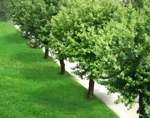Recently we were called in to consult on some highway noise that was affecting a residential community. The state had added a new exit ramp that diverged right through the back property lines of several of the residences. While we talked with one of the home owners, he asked about the acoustical effects of planting more trees and foliage between his house and the new exit ramp. As Acoustical Consultants, this is something we hear all the time: the idea that trees and plants can effectively mitigate loud noise. Hopefully, this blog will help put to rest some of the myths about acoustical attributes of trees: where they fail and where they succeed.
Where They Fail: Noise Reduction
Planting a single row of trees near a busy road will provide an instant visual obstruction, but will not produce a reduction in noise. Experts agree that even several rows of trees will not offer a perceivable decline in noise. In fact, to achieve noticeable results, one would have to plant about one hundred feet of dense trees and foliage between the noise and the listener – we’re talking a small woods here – before they would notice a positive change. In his book, Concepts in Architectural Acoustics, expert David Egan explains that “trees and vegetation are not normally effective as sound barriers.” He goes onto explain how it takes about 100′ of thick overgrowth before listeners will start to notice a reduction in sound. We have to remember that open ground attenuates sound too, so when the ground is covered with heavy trees and foliage, some of the natural acoustical absorption (from the earth’s porous nature) will be negated. You can even end up going two steps forward and three steps back.
But what about the leaves? Tree leaves do provide a nominal level of diffusion; in other words they can scatter some of the sound (specifically in the higher frequencies) but it will not result in an overall reduction of noise. It’s a two-edged sword because winds will cause vibration in the leaves, creating a rustling sound and adding to the noise floor. And of course, when deciduous trees drop their leaves in the autumn, any positive effect (if even perceivable) is negated.
Where They Succeed: Psychoacoustics
Much research has been done to support the preceding claims, even by the Federal Highway Administration who states: “Trees and other vegetation can be planted for psychological relief but not to physically lessen noise levels” (http://www.fhwa.dot.gov/environment/keepdown.htm). Of note here is their reference to “psychological relief.” This is another way of referring to psychoacoustics: the idea that the brain itself can alter a sound based on certain stimuli – even though the actual sound (with its volume, frequency, reverberation, and so forth) has not changed a bit. In our scenario then, the visual stimuli of the tree line could alter the psychoacoustics in someone’s head (making them “feel” as if the noise has been reduced) when in fact, it is every bit as loud as it was to begin with. Yikes! (Cue Twilight Zone music here.)
Of course, there are a million other great reasons to plant trees and vegetation including the environment, aesthetics, and oh-yeah… did I mention the environment? We all need to do our part in caring for the earth, and planting trees is a great way to do it. But when you do, don’t expect to change the world of sound around you. If it does make a significant change in the volume level, just close your eyes and say “It’s all in my head!” because at the end of the day, you’re probably barking up the wrong tree.
